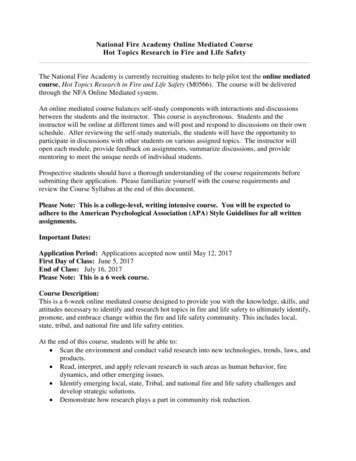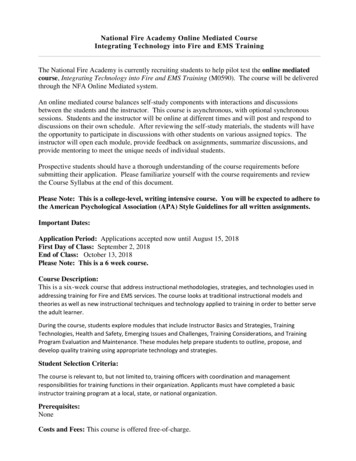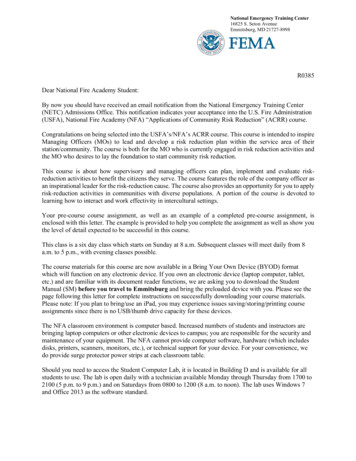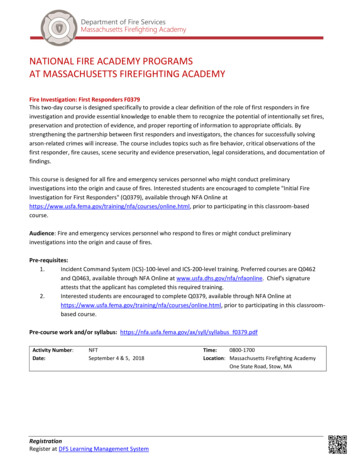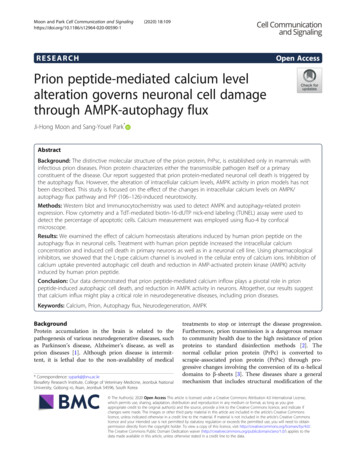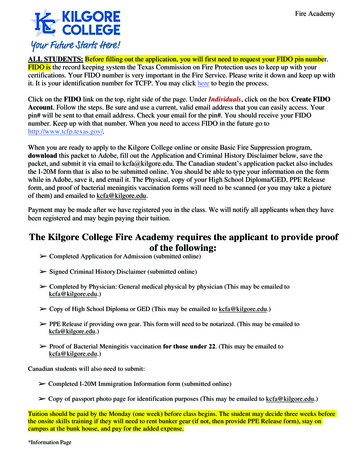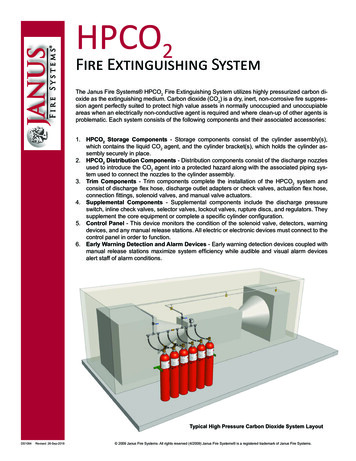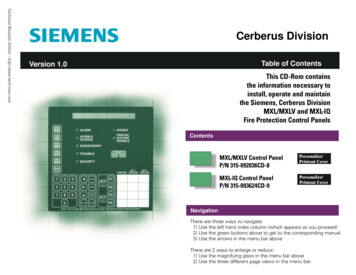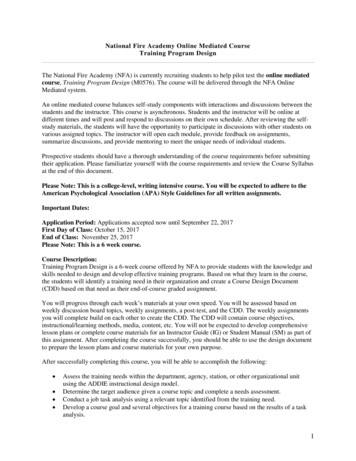
Transcription
National Fire Academy Online Mediated CourseTraining Program DesignThe National Fire Academy (NFA) is currently recruiting students to help pilot test the online mediatedcourse, Training Program Design (M0576). The course will be delivered through the NFA OnlineMediated system.An online mediated course balances self-study components with interactions and discussions between thestudents and the instructor. This course is asynchronous. Students and the instructor will be online atdifferent times and will post and respond to discussions on their own schedule. After reviewing the selfstudy materials, the students will have the opportunity to participate in discussions with other students onvarious assigned topics. The instructor will open each module, provide feedback on assignments,summarize discussions, and provide mentoring to meet the unique needs of individual students.Prospective students should have a thorough understanding of the course requirements before submittingtheir application. Please familiarize yourself with the course requirements and review the Course Syllabusat the end of this document.Please Note: This is a college-level, writing intensive course. You will be expected to adhere to theAmerican Psychological Association (APA) Style Guidelines for all written assignments.Important Dates:Application Period: Applications accepted now until September 22, 2017First Day of Class: October 15, 2017End of Class: November 25, 2017Please Note: This is a 6 week course.Course Description:Training Program Design is a 6-week course offered by NFA to provide students with the knowledge andskills needed to design and develop effective training programs. Based on what they learn in the course,the students will identify a training need in their organization and create a Course Design Document(CDD) based on that need as their end-of-course graded assignment.You will progress through each week’s materials at your own speed. You will be assessed based onweekly discussion board topics, weekly assignments, a post-test, and the CDD. The weekly assignmentsyou will complete build on each other to create the CDD. The CDD will contain course objectives,instructional/learning methods, media, content, etc. You will not be expected to develop comprehensivelesson plans or complete course materials for an Instructor Guide (IG) or Student Manual (SM) as part ofthis assignment. After completing the course successfully, you should be able to use the design documentto prepare the lesson plans and course materials for your own purpose.After successfully completing this course, you will be able to accomplish the following: Assess the training needs within the department, agency, station, or other organizational unitusing the ADDIE instructional design model.Determine the target audience given a course topic and complete a needs assessment.Conduct a job task analysis using a relevant topic identified from the training need.Develop a course goal and several objectives for a training course based on the results of a taskanalysis.1
Course Syllabus Training Program DesignSelect a course organizational strategy or strategies based on a course goal and terminal objective.Develop appropriate instructional methods and learning activities for an instructional task.Determine Instructor Guide and Student Manual formats suitable for use in the course design.Evaluate a course and its learners.Develop a Course Design Document.Student Selection Criteria:The target audience for this course includes: Experienced Emergency service personnel with course design and development responsibilities.Volunteer and career trainers/instructors at a local level, whose educational backgrounds maycover a range from high school graduates to masters.Prerequisites:Before taking Training Program Design, you will have completed: Incident Command System (ICS)-100-level and ICS-200-level training.Fire Instructor 1 or equivalent.The related course Training Program Management (R0342) is not a prerequisite and may be taken beforeor after Training Program Design.Costs and Fees: This course is offered free-of-charge.How to Apply:Students must complete the General Admission Application ( FEMA Form 119-25-1) available on theUSFA website at: apply.htmlCompleted applications should be submitted by September 22, 2017 to:NETC Admissions Office16825 S. Seton AvenueEmmitsburg, MD 21727Completed applications can also be faxed to the NETC Admissions Office at 301-447-1441.Please direct any questions related to your attendance at this course offering to:David Donohue, Training Specialist301-447-1094David.Donohue@fema.dhs.gov2
Course SyllabusTraining Program DesignNational Fire AcademyM0576 – Training Program DesignVersion: 1st edition, April 2017Quarter:ACE Credit:IACET Continuing Education Units:Length of Course: Six WeeksPrerequisite:Incident Command System (ICS)-100-level and ICS-200-level trainingFire Instructor 1 or equivalentCurriculum:Training Specialist:Instructor:Instructor email/phone:Classroom: OnlineMeeting Time: OnlineTable of ContentsCourse Description (Catalog). 5Student Qualifications . 5Course Scope (Goal) . 5Course Objectives (Course Learning Outcomes – TLOs) . 6Course Delivery Method . 6Course Resources (Instructional Materials) . 8Grading Methodology (Evaluation Procedures) . 8Course Outline . 11Policies . 16Grading Rubrics . 203
Course SyllabusTraining Program DesignThis page left intentionally blank.4
Course SyllabusTraining Program DesignCourse Description (Catalog)Training Program Design is a 6-week course offered by NFA to provide students with the knowledge andskills needed to design and develop effective training programs. Based on what they learn in the course,the students will identify a training need in their organization and create a Course Design Document(CDD) based on that need as their end-of-course graded assignment.You will progress through each week’s materials at your own speed. You will be assessed based onweekly discussion board topics, weekly assignments, a post-test, and the CDD. The weekly assignmentsyou will complete build on each other to create the CDD. The CDD will contain course objectives,instructional/learning methods, media, content, etc. You will not be expected to develop comprehensivelesson plans or complete course materials for an Instructor Guide (IG) or Student Manual (SM) as part ofthis assignment. After completing the course successfully, you should be able to use the design documentto prepare the lesson plans and course materials for your own purpose.Student QualificationsThe target audience for this course includes: Experienced Emergency service personnel with course design and development responsibilities.Volunteer and career trainers/instructors at a local level, whose educational backgrounds maycover a range from high school graduates to masters.PrerequisitesBefore taking Training Program Design, you will have completed: Incident Command System (ICS)-100-level and ICS-200-level training.Fire Instructor 1 or equivalent.The related course Training Program Management (R0342) is not a prerequisite and may be taken beforeor after Training Program Design.Course Scope (Goal)The goal of the course is to teach you how to apply and use an accepted instructional design process(ADDIE) and how to develop a Course Design Document.5
Course SyllabusTraining Program DesignCourse Terminal Learning Objectives (Learning Outcomes)After successfully completing this course, you will be able to accomplish the following: Assess the training needs within the department, agency, station, or other organizational unitusing the ADDIE instructional design model.Determine the target audience given a course topic and complete a needs assessment.Conduct a job task analysis using a relevant topic identified from the training need.Develop a course goal and several objectives for a training course based on the results of a taskanalysis.Select a course organizational strategy or strategies based on a course goal and terminal objective.Develop appropriate instructional methods and learning activities for an instructional task.Determine Instructor Guide and Student Manual formats suitable for use in the course design.Evaluate a course and its learners.Develop a Course Design Document.Course Delivery MethodThis distance learning (mediated) course enables you to complete academic work in a flexible manner,completely online.During each of the first five weeks of the course, you will be expected to submit one discussion boardthread and two posts responding to other students' threads each week. The weekly discussion board willopen at the beginning of each week (Sunday 11:59 p.m. EDT/EST. You will be expected to post yourweekly discussion board thread no later than Wednesday (11:59 p.m. EDT/EST). The boards will closefor responses on Friday (11:59 p.m. EDT/EST).During each of the first five weeks you will also be assigned one assignment related to the course contentfor that week. Assignments will be submitted no later than the first day of the following week (Monday,11:59 p.m. EDT/EST).During the last week of the course, you will complete a post-test and your Course Design Document.Both must be completed by the Monday (11:59 p.m. EDT/EST) following the end of the course.Instructors will provide timely feedback and support throughout the course. You are responsible forapplying that feedback to your CDD.6
Course SyllabusTraining Program DesignCourse ScheduleThe purpose of this schedule is to give you, at a glance, the required preparation, activities, and evaluationcomponents of your course. All due dates refer to 11:59 p.m. EDT/EST.WeekActivityWeekly Assignment Complete pre-course tasks.Precourse Take the pre-test.N/A Read required pre-course reading. Read the required reading.1 Post your discussion board thread by Wednesday. Respond to at least two other students' postings byFriday.Week 1 Assignment: NeedsAssessment and AudienceAnalysis Submit Week 1 Assignment: Needs Assessment andAudience Analysis by Monday.2 Read the required reading. Post your discussion board thread by Wednesday.Week 2 Assignment: Job TaskAnalysis Respond to at least two other students' postings byFriday. Submit Week 2 Assignment: Job Task Analysis byMonday.3 Read the required reading. Post your discussion board thread by Wednesday.Week 3 Assignment: Goals,Objectives, and CourseOrganization Respond to at least two other students' postings byFriday. Submit Week 3 Assignment: Goals, Objectives, andCourse Organization by Monday.4 Read the required reading. Post your discussion board thread by Wednesday.Week 4 Assignment:Instructional Methods, Media,and Tools Respond to at least two other students' postings byFriday.7
Course SyllabusWeekTraining Program DesignActivityWeekly Assignment Submit Week 4 Assignment: Instructional Methods,Media, and Tools by Monday.5 Read the required reading. Post your discussion board thread by Wednesday.Week 5 Assignment: CourseEvaluation Plan Respond to at least two other students' postings byFriday.6 Submit Week 5 Assignment: Course Evaluation Planby Monday. Take the post-test by the following Monday.Submit your final CourseDesign Document to theinstructor by the followingMonday.Course Resources (Instructional Materials)All materials needed for this course are available online through the course classroom and on the web. Noadditional materials are required.Course NotebookThroughout the course, you will be asked to take notes, store job aids, and record your ideas in a coursenotebook. This could take the form of a paper notebook, the Binder app, a Microsoft Word document, ablog, or whatever you’re most comfortable using. In addition to helping you plan for and create theassignments for this course, keeping a course notebook produces a valuable job aid you can continue touse after the course has ended.Required ReadingsYou must complete required readings during the course to be able to thoughtfully participate in discussionboards and written assignments.The weekly required readings and resources have been selected to challenge the student and serve asprimary sources for citation for the discussion board.Suggested Readings/ResourcesSuggested readings are not evaluated, but they may enhance the your understanding and promotediscussion.Chuck Hodell’s ISD From the Ground Up: A No-nonsense Approach to Instructional Design (2000) is anexcellent resource for instructional designers. You may want to purchase it as a reference both during andafter the course.Grading Methodology (Evaluation Procedures)8
Course SyllabusTraining Program DesignThis section provides instructions on how to initiate and respond to discussions. A “New Thread” isstarted each time you submit an original discussion topic. Generally, the initial post will be 150 to 300words, and the follow-up responses will be 75 to 200 words. Refer to discussion post assignment gradingrubric for specifics.Weekly Discussion Board AssignmentsDiscussion board assignments give you an opportunity to reflect on the course, analyze the material, andshare opinions with your peers. Responses should follow these guidelines:Demonstrate an analysis of the questions and material while showing an application of your own thinkingon the discussion question. Also, comment on two other students’ post and any follow-up questions tofurther demonstrate discussion board question insight, synthesis, analysis, and position or argument.Questions must be answered concisely and accurately.Responding to the main topic: A good title tells something of the nature of your personal response.“Response to Discussion 1,” for example, is not a very useful title, particularly if everyone in your courseuses it. Try to use topic words that will identify your topic: “Response to discussion about culture changeat the company level.”Responding to someone else's response: Make sure that you respond on the document intended so thatyour contribution will line up in the threaded discussion in the right place.Quality discussion responses: Responses such as "I agree," "good question" or "good answer" are notacceptable. Any response that is just an opinion or is unsubstantiated; any response that is carelesslytyped, poorly thought out, grammatically incorrect, or confusing; or any response that is disrespectful ofanother student or any other person, etc., is not acceptable. A high-quality response applies a conceptfrom the text or course in a meaningful way or facilitates analysis of the course material or topic.Responses should indicate that you have critically thought about the discussion topic and demonstrate thatyou can apply and articulate the knowledge you are learning. Your responses should be well-organizedand grammatically correct. Substantive responses do not simply deliver opinions; they offer justificationfor those opinions and should cite sources when appropriate.Expected quantity of responses: Full participation in each discussion requires that you not only respondto the initial discussion item but that you return later to read the responses of others and respond to at leasttwo other people's comments per discussion item. Treat it as a conversation. Think about how you wouldfeel if you made an observation in a traditional classroom setting and no one responded.Discussion open and close dates: Be sure to note the start and end dates of the discussions and responsesin the unit’s forum.Grading: Completion of weekly discussion board questions and responses accounts for 10% of the totalcourse grade. The discussion forum’s grading rubric can be found on Page 16.Written AssignmentsThere are written assignments in this course that serve to assist you in gaining a better analysis of thecourse materials and in creating your final Course Design Document.9
Course SyllabusTraining Program DesignFor your written assignments, you will be required to use the "Publication Manual of the AmericanPsychological Association," sixth edition. The American Psychological Association (APA) style websiteprovides a guideline, examples from books to online articles, FAQs, and even a detailed tutorial forbeginning users. Please bookmark this site so you can refer to it for assistance throughout the 560/01/ or http://www.apastyle.org).Guidelines: The weekly assignments are evaluated on content (demonstrates both analyzing andapplication of course material and displays critical thinking) and quality (grammar, syntax, structure, andcompliance with APA sixth edition formatting). The file name for your assignment paper needs to reflectyour name and the assignment (e.g., Week1-Assignment John Doe.pdf).Grading: Completion of the five (5) weekly assignments accounts for 50% of the total grade. Theseassignments are due on Monday (11:59 p.m. EDT/EST) of the next week.The Course Design Document accounts for 30% of the total grade and is due the Monday followingcourse completion. The grading rubric for all assignments can be found starting on Page 16.10
Course SyllabusTraining Program DesignCourse OutlinePre-course Modules (Course Overview and Welcome and Course Tools)ActivityDirectionsDiscussion Post:IntroduceYourselfIntroduce yourself to the class:1. Tell us a little bit about yourself and where you live/work.2. Tell us about your department/agency, your position and responsibilities,and what you hope to gain from this course.3. Respond to another student.4. Complete to unlock Week 1.Dropbox CourseToolComplete to unlock Week 1.Academic Code ofConduct andEthics QuizComplete to unlock Week 1.Training ProgramDesign Pre-testComplete to unlock Week 1.Pre-courseRequired ReadingComplete to unlock Week 1.Week 1: Needs-Based Instructional DesignTerminal Learning ObjectivesAt the completion of this week, the students will be able to: Assess the training needs within the department, agency, station, or other organizational unitusing the ADDIE instructional design model.Determine the target audience given a course topic and complete a needs assessment.Enabling Learning ObjectivesThe students will be able to:1.2.3.4.5.Analyze the phases of the Instructional Systems Design process using ADDIE.Describe the roles of the instructor and the instructional designer.Classify performance gaps as motivational, environmental, selection, or training problems.Assess training needs using a needs assessment process.Evaluate the audience using an audience analysis.11
Course SyllabusTraining Program DesignActivityDirections Adult Learning: Challenges for Instructors of Adult Learners Designing Adult Training (Part 1 of 3): Training Needs AssessmentRequiredReadings
National Fire Academy Online Mediated Course Training Program Design The National Fire Academy (NFA) is currently recruiting students to help pilot test the online mediated course, Training Program Design (M0576). The course will be delivered through the NFA Online Mediated system. An onlin
